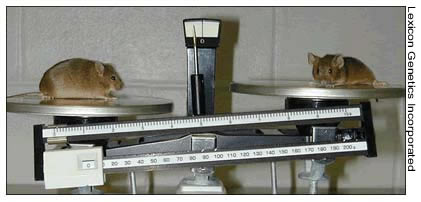

Fact Sheet On October 5, 2005, NIH announced that contracts had been signed with two companies, Deltagen, Inc. and Lexicon Genetics, Inc., to provide knockout mouse lines and extensive phenotyping data on them to NIH. NIH wishes to make these mouse lines and data as widely available to the research community as possible. The following document provides details of the contract and information on how investigators can access the mouse resources and data. How many mouse lines were obtained, and how were they chosen? 251 lines of mice, each with a different gene knocked out, and detailed phenotypic data on them, were obtained. The choice of the 251 lines was made from a total list of 1840 mouse lines available from the two companies. The 19 Institutes, Centers, and Offices at NIH that contributed funds to obtain mice under the contracts chose the lines obtained. Where can researchers find the list of mouse lines obtained? Information on the mouse lines obtained can be found on the NIH Model Organisms Mouse Resources website. The list of mouse lines and phenotypic data obtained, and links to their Mouse Genome Informatics summaries and the Repository from which each line may be obtained, is on the List of Available Knockout Mice page. How do researchers gain access to the mouse materials obtained under the contracts? For each mouse line, frozen embryos, sperm, and embryonic stem (ES) cells were obtained under the contract. The materials were equally divided between the NIH-sponsored Mutant Mouse Regional Resource Center ( MMRRC ) repositories at UC Davis and the University of North Carolina , and The Jackson Laboratory. The repositories will expand and archive these materials and deliver the ES cells, frozen embryos, and live mice available upon request to the biomedical research community. Expansion of the materials will occur on a rolling basis and will require approximately six months to complete. Researchers can register interest in receiving the materials when they are ready for distribution by following the links to the repository that received that particular line, listed on the List of Available Knockout Mice page. How much will investigators pay to receive the mouse materials? The costs for the mouse materials will be the same as the usual costs charged by the repositories for these materials on similar lines. These fees cover shipping and continued regeneration and rebanking of the mouse materials. What restrictions exist on the use of the mouse materials? The mouse materials may be sent by the repositories to any academic or non-profit organization worldwide, but may not be sent to commercial organizations. The only restriction on the use of the mouse materials is that they may not be used for industry-funded contract research. There are absolutely no publishing or intellectual property restrictions on the use of the mouse materials . Researchers are free to publish and seek patents on results obtained using the mice without restriction. Commercial organizations must secure a license directly from the respective owner, Deltagen or Lexicon, in order to obtain the mouse materials. How do researchers gain access to the phenotypic data obtained under the contracts? The phenotypic data are rich and wide-ranging, and are quite similar between the two companies from which the mouse lines were obtained. Within a company, the phenotyping was done in a uniform, well-documented way in the same facilities by the same personnel, making comparisons of a wide variety of phenotypes across mutant strains uniquely possible. The phenotypic data on all 251 mouse lines will be made available on the Mouse Genome Informatics website at The Jackson Laboratory ( http://www.informatics.jax.org ), in three stages. First and currently available are weblinks to the phenotypic data reports on each line, available at http://www.informatics.jax.org/external/ko/. Second, assignment of MGI controlled phenotypic terms to the mutant strains with links to the phenotypic data reports (see http://www.informatics.jax.org/searches/allele_form.shtml ); and third, integration of the raw data into a fully searchable database format. We expect the first two stages to occur over the next two months. The integration of all raw data into MGI will be a longer process, but will be made available as quickly as possible. What restrictions exist on the use of the phenotypic data? There are absolutely no restrictions on the use of the phenotypic data. Researchers throughout the world, in the public and private sectors, are free to publish and seek patents on results obtained using the phenotypic data without restriction. Will other lines of mice with other genes knocked out be available in the future through these contracts? The contracts allow acquisition of more lines and phenotypic data under the same terms for the next three years. There are over 1500 additional lines that are available from the two companies, but there is currently no NIH-sponsored funding assigned to acquiring these lines. The list of additional lines will be posted on the NIH Model Organisms Mouse Resources page. Since the contracts can be utilized by all parts of NIH, researchers who are interested in obtaining these mice should contact the program officer(s) on their NIH grant(s) to discuss this. NIH is currently working out mechanisms to streamline this process; updates will be posted on this page as well as the websites of the MMRRC and The Jackson Laboratory. Which parts of NIH contributed to the procurement of these knockout mice and phenotypic data? National Center for Complementary and Alternative Medicine Whom do I contact with specific questions? Questions about the acquisition and contracts should be directed to the contract project officer: Colin Fletcher, Ph.D. Questions about availability and ordering of individual lines
should be directed to the repository to which each line has been
assigned. This is indicated on the list of mouse lines at List
of Available Knockout Mice page.
Mutant Mouse Regional Resource Center (MMRRC): Customer Service, 1-800-910-2291 (North America) or 1-207-288-6009 (outside North America ), service@mmrrc.org At the MMRRC-UC Davis, contact 1-530-754-8686, mmrrc@ucdavis.edu At the MMRRC-UNC, contact 1-919-966-9443, MMRRCtech@listserv.med.unc.edu |
![]()
